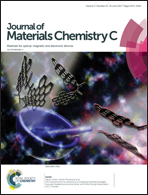Red-light emission and dielectric reversible duple opto-electronic switches in a hybrid multifunctional material: (2-methylimidazolium)MnCl3(H2O)†
Abstract
Optoelectronic duple-functional organic–inorganic materials are capable of imparting multiple desirable properties in one device cell for ultra-encrypted and highly integrated data storage, communication, signal processing and sensing. However, multifunctional switchable materials, especially those with bistable photoluminescent/dielectric switching properties, are rarely reported. The exceptional compatibility of optoelectronic duple switching is much superior to the current predominant multifunctional devices. Here, a new organic–inorganic hybrid compound, (2-methylimidazolium)MnCl3(H2O) (1), was found to behave as a potential optical–electrical duple bistable switch (with both optical and electrical switching “ON” and “OFF”), which undergoes a reversible order–disorder structural phase transition, then triggering an extraordinary photoluminescent/dielectric transformation. This compound provides a concrete example of optoelectronic multifunctional switching materials and may promote the development of desirable devices.



 Please wait while we load your content...
Please wait while we load your content...